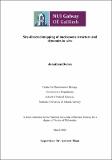| dc.contributor.advisor | Flaus, Andrew | |
| dc.contributor.author | Doran, Jonathan | |
| dc.date.accessioned | 2013-08-07T14:52:26Z | |
| dc.date.available | 2014-09-22T15:11:33Z | |
| dc.date.issued | 2013-03-04 | |
| dc.identifier.uri | http://hdl.handle.net/10379/3608 | |
| dc.description.abstract | The nucleosome core particle is the most basic unit of chromatin packaging. It is composed of an octamer of two each of the histone proteins H2A, H2B, H3 and H4 wrapped in ~147 bp of DNA. Nucleosome positioning and sliding are distinct dynamic properties of nucleosomes pivotal for essential chromatin processes such as replication, transcription and repair.
To gain a better understanding of these properties site-directed mutagenesis was used to introduce a cysteine residue onto the surface of the octamer at each of the seven super helical location (SHL) points of contact on the pseudo dyad symmetric nucleosome. An EDTA/Fe2+ derivative or a 1,10-phenanthroline/Fe2+ derivative was then tethered to the cysteine adjacent to the SHL points of contact. When activated, these derivatives generate hydroxyl radicals, which break the DNA backbone adjacent to the point of contact. Denaturing PAGE can then be used to determine the size of these DNA fragments at base-pair resolution, which can be mapped back to the SHL points of contact.
Site-directed mapping was carried out on nucleosomes containing the well- characterised 147 bp MMTV NucA, 601 and 601.2 nucleosome positioning sequences. This showed that NucA, 601 and 601.2 were structurally equivalent, that EDTA and phenanthroline derivatives produced distinct mapping patterns, and that transient dynamics within the nucleosome could be interpreted.
EDTA/Fe2+ mapping at each of the SHL points of contact was used to investigate the mechanism of nucleosome sliding for thermally mobilised nucleosomes incubated at 37°C and 45°C. These results suggest nucleosome sliding along a 221 bp MMTV NucA DNA sequence proceeded in near single base-pair steps, without any large-scale metastable intermediate structures being observed.
Taken together, the results indicate that the nucleosome structure in solution is consistent with those of static crystal structures. It also indicates that nucleosome sliding occurs in near single base-pair steps characteristic of a twist defect diffusion mechanism. Finally, the mapping observed with the reagents used indicate that they occupy different positions within the minor groove and this high resolution characterisation of their behaviour provides the basis for expanding investigations of nucleosome properties in vitro and in vivo. | en_US |
| dc.rights | Attribution-NonCommercial-NoDerivs 3.0 Ireland | |
| dc.rights.uri | https://creativecommons.org/licenses/by-nc-nd/3.0/ie/ | |
| dc.subject | Nucleosome | en_US |
| dc.subject | Site-directed mapping | en_US |
| dc.subject | Chromatin | en_US |
| dc.subject | Hydroxyl radical | en_US |
| dc.subject | School of Natural Sciences | en_US |
| dc.subject | Biochemistry Department | en_US |
| dc.title | Site-directed mapping of nucleosome structure and dynamics in vitro | en_US |
| dc.type | Thesis | en_US |
| dc.contributor.funder | Health Research Board | en_US |
| dc.contributor.funder | Science Foundation Ireland | en_US |
| dc.contributor.funder | Thomas Crawford Hayes Trust Fund | en_US |
| dc.local.note | DNA within the cell is composed of nucleoprotein complex called chromatin, the basic unit being the nucleosome. A molecular scissors was attached to the nucleosome surface and used to cut the DNA at specific locations. Using this strategy I compare different nucleosome species and determine a mechanism for nucleosome sliding. | en_US |
| dc.local.final | Yes | en_US |
| nui.item.downloads | 168 | |


